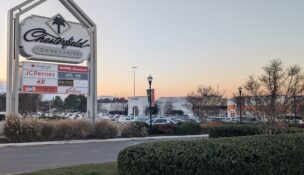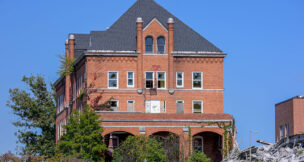
Descendants of Oak Hill sharecroppers stand outside the ruins of the property’s plantation house. AP Photo/Ben Finley

Descendants of Oak Hill sharecroppers stand outside the ruins of the property’s plantation house. AP Photo/Ben Finley
Danville-Pittsylvania authority invests in history
Using a $1.89 million loan from the Virginia Small Business Financing Authority, Danville and Pittsylvania County officials plan to purchase about 289 acres adjacent to the Southern Virginia Megasite at Berry Hill.
Members of the Danville-Pittsylvania Regional Industrial Facility Authority (RIFA) unanimously agreed in January to move forward with purchasing the land at 5981 Berry Hill Road, the site of the former Oak Hill plantation, from the estate of Waller Hairston.
The goal of the purchase isn’t to prep more acreage for a potential boom of development following the November announcement that Microporous, a Tennessee-based manufacturer of battery separators, plans to invest $1.35 billion to build a manufacturing facility at the Berry Hill industrial park.
“This is not going to be part of the megasite,” Matt Rowe, director of economic development for Pittsylvania County, stresses.
The main home on the property, mostly destroyed by a 1988 fire, was believed to have been built in the first quarter of the 19th century and was owned by Samuel Hairston, who has been described as the largest enslaver in the South. The site includes the ruins of the home, as well as those of quarters for enslaved people and a terraced garden.
“There’s significant cultural elements on the property,” says Rowe. “Historically, only the plantation owners’ history has been told, and I know it’s very important to the RIFA board to tell all of the history.”
Purchasing the Oak Hill property also provides a solution to a problem the authority has wrestled with since the localities began developing the 3,528-acre megasite in 2008: what to do about two cemeteries, believed to be populated by former enslaved people and tenant farmers, who lived between 1870 and 1950, that are located on the park’s Lot 3. For RIFA members, the chief concern, according to Rowe, is that development of the megasite might somehow impede access to the graves.
In October, RIFA members approved plans to pay up to $353,533 to WSP USA, a New York professional services firm, to relocate more than 100 unmarked graves to another area of the megasite that’s close to the Oak Hill property.
“Our goal would likely be to do … a boundary line adjustment to put that entire consolidated cemetery all on the same property as that of the plantation home and the other … historic elements to create this one central cultural lot,” Rowe says.
-

















